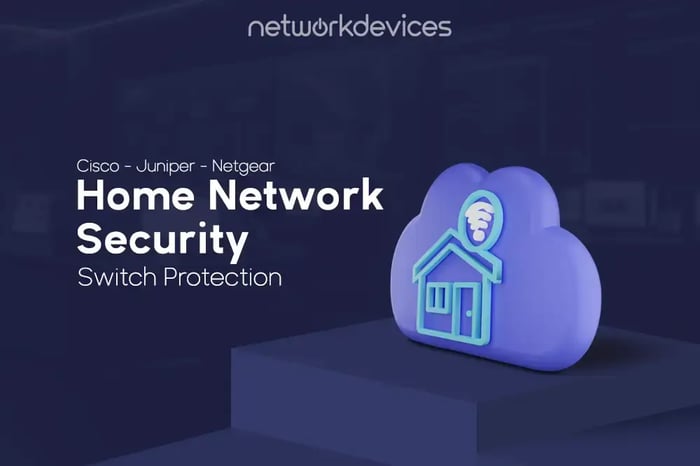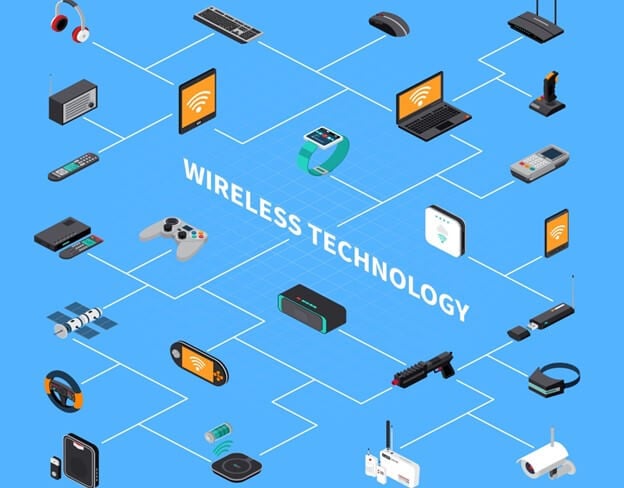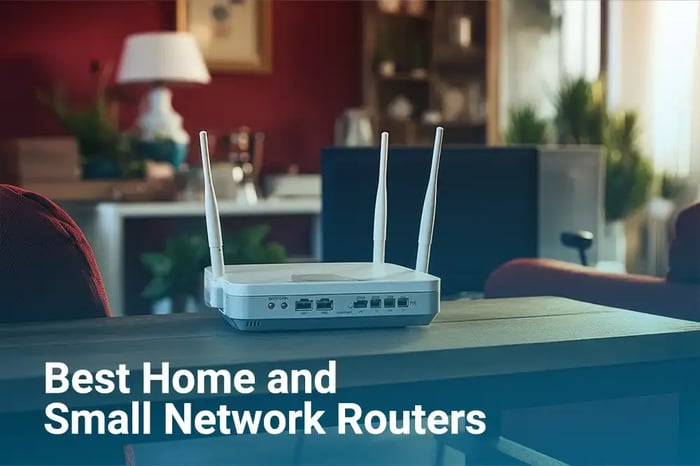You have no items in your shopping cart.

Home Network Security: Switch Protection
Keeping your home network secure has never been more critical, especially as cyber threats continue to rise. The Global Cybercrime cost will reach 15.63 trillion U.S. dollars by 2029. This shows the increasing importance of securing home networks such as switches that are often targeted by hackers looking to exploit vulnerabilities.
With switch security, you can prevent unauthorized access, data interception, and other common network threats, ensuring the safety of your devices and data.
This article explores the essential types of switch security protections and provides practical tips for implementing them in a home network environment.

Understanding Switch Security and its Importance
Switch security involves various protections to shield your network from cyber threats, such as denial-of-service and man-in-the-middle attacks. As smart homes grow, with IoT devices connecting everything from laptops to lights, securing your home network switch becomes essential.
Several risks can target network switches. With over 75 billion IoT devices predicted to be in use by 2025, securing your home network and Ethernet switches is essential.
One common threat is unauthorized access, where an outsider gains control of your network. This can lead to data theft or misuse of your internet connection. Another risk is data interception, where attackers capture sensitive information traveling over the network.
To protect your network, it is important to understand these threats and how they can impact your devices. You can help keep your home network safe and secure by implementing proper security measures. Switch security is not just for businesses; it is crucial for anyone who wants to protect their personal information at home.
Types of Switch Security Protections
Several types of switch security protections can be implemented to keep your network safe. Each protection method addresses specific vulnerabilities and helps strengthen overall security.

Secure Remote Access with SSH
Secure remote access allows network administrators to manage switches from a distance. Protocols like SSH (Secure Shell) are crucial because they encrypt the connection.
Any data sent between the administrator and the switch is protected from eavesdroppers. Avoid using Telnet, as it sends data in plain text, making it easy for attackers to intercept sensitive information.
VLANs (Virtual Local Area Networks)
VLANs (Virtual Local Area Networks) create isolated network segments, reducing congestion and enhancing security. This separation keeps devices like smart TVs and computers on separate networks, lowering the risk of cross-device threats.
Enhance Switch Security with Port Security
Switch port security is a feature that controls how devices connect to your switch. It helps prevent unauthorized devices from accessing the network. This can be done through various methods:
- Static MAC Addressing: Only allows specific devices with known MAC addresses to connect.
- Dynamic MAC Addressing: Learns and allows new devices but limits how many can connect.
- Sticky MAC Addressing: Automatically saves the MAC addresses of connected devices for future access.
You reduce the risk of unauthorized access by setting limits on how many devices can connect.
Access Control Lists (ACLs) for Traffic Filtering
Access Control Lists (ACLs) are rules that filter traffic entering or leaving a switch. They help determine which devices can communicate with each other based on IP addresses or protocols.
Using ACLs, you can block unwanted traffic and ensure that only authorized users can access certain parts of your network.
Prevent Rogue DHCP Servers with DHCP Snooping
DHCP snooping is a security feature that protects against rogue DHCP servers. A rogue server can assign incorrect IP addresses, disrupting network communication.
With DHCP snooping enabled, the switch only allows trusted DHCP servers to distribute IP addresses. This helps maintain proper network configuration and prevents attacks.
802.1X Authentication for Network Access Control
802.1X is a network access control method that requires users to authenticate before connecting to the network. This adds an extra layer of security, ensuring that only authorized users and devices can access network resources.
Implementing these security protections can significantly enhance the safety of your network switches and protect sensitive data from potential threats.
Top Ethernet Switches for Home Use
Selecting the right Ethernet switch for your home can significantly enhance your network performance. Here are three highly recommended switches that offer excellent features suited for home use:
1. Netgear GS324-200EUS
- Ports: 24 Gigabit Ethernet ports
- Form Factor: Rack-mounted
- Cooling: Fanless design
- Warranty: 5 years
Technical Features
The Netgear GS324 is a robust switch with 24 Gigabit Ethernet ports, allowing multiple devices to connect simultaneously.
Its fanless design ensures quiet operation, making it suitable for home environments. With a metal housing for durability, this unmanaged switch provides plug-and-play functionality, making setup straightforward.
Why It's Suitable for Home Use
Ideal for larger households or home offices, the GS324 supports heavy network traffic, ensuring that all devices, from computers to smart TVs, receive reliable connections without lag. Its high port count also allows for future expansion as your network needs to grow.
2. Cisco SG250-50P-K9
- Ports: 50 Gigabit Ethernet ports
- PoE: Yes (Power over Ethernet)
- Management: Smart Managed
- Warranty: Limited Lifetime
Technical Features
The Cisco SG250-50P-K9 is a smart managed switch with 50 Gigabit ports, including PoE capabilities. This allows you to power devices such as IP cameras and access points directly through the switch.
It features an intuitive web interface for easy management, VLAN support, and quality of service (QoS) settings to prioritize critical traffic.
Why It's Suitable for Home Use
The SG250-50P-K9 simplifies cabling by providing power and data to compatible devices, perfect for tech-savvy users and smart homes.
Its extensive management features allow users to customize their network for optimal performance, making it a solid investment for those with multiple connected devices.
3. Juniper EX2300-C-12T
- Ports: 12 Gigabit Ethernet ports
- Form Factor: Compact, rack-mountable
- Cooling: Fanless design
- Warranty: 1 year
Technical Features
The Juniper EX2300-C-12T is a compact switch with 12 Gigabit Ethernet ports designed for smaller networks.
Its fanless design ensures quiet operation, while its robust hardware is built to handle various network environments. It supports features like VLANs and quality of service (QoS) for efficient traffic management.
Why It's Suitable for Home Use
This switch is ideal for users with smaller setups, such as home offices or apartments. Its compact size allows it to fit seamlessly into any space, while the high-speed ports ensure that your devices maintain strong connections.
The EX2300-C-12T’s advanced features make it an excellent choice for users seeking a reliable and efficient networking solution.
Product Selection Criteria
When looking for a home Ethernet switch, keep these features in mind:
- Port Security: Look for switches that offer features like port security to prevent unauthorized access.
- Remote Management: Switches with remote management capabilities allow you to monitor and configure settings from anywhere.
- VLAN Support: VLAN support helps you segment your network, improving security and performance.
Best Practices for Securing Your Home Network Switch
Following best practices when setting up and managing your Ethernet switch is important to protect your home network from potential security threats. Here are some essential steps to enhance the security of your switch:
1. Change Default Passwords
Many switches come with default usernames and passwords, which can be easily exploited. To prevent unauthorized access, always change these to strong, unique passwords as soon as you set up your switch.
2. Enable Port Security
Use port security to limit the number of devices connecting to each port on your switch. This can help prevent unauthorized devices from joining your network.
3. Use VLANs (Virtual LANs)
VLANs allow you to segment your network, adding an extra security layer. Keeping sensitive devices, like security cameras or smart home systems, on a separate VLAN reduces the risk of network-wide breaches.
4. Regularly Update Firmware
Manufacturers often release firmware updates to fix vulnerabilities. To protect against known security risks, ensure your switch is running the latest version of its firmware.
5. Monitor Network Traffic
Keep an eye on your network traffic using built-in monitoring tools or external software. Unusual activity could indicate a potential security issue that needs immediate attention.
6. Disable Unused Ports
If your switch has ports that are not in use, disable them. This reduces the chances of an attacker plugging an unauthorized device into your network.
Wrapping Up
Switch security is essential to a safe, resilient home network. Implementing features like SSH, VLANs, and port security can help prevent unauthorized access and keep your data secure.
If you’re interested in learning how home automation can enhance your living environment, explore our guide on Home Automation Switches.






